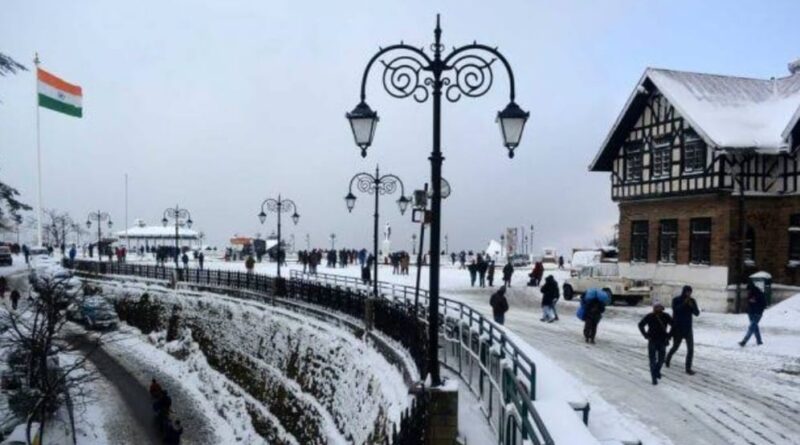Shimla’s Disappearing Snow: A Wake-Up Call for the ‘Queen of Hills’
Shimla, once synonymous with picture-perfect snowfall and winter charm, is witnessing a drastic decline in snowfall, raising serious concerns among environmentalists, hoteliers, and local residents. Snowfall in the region has declined by 37% between 1990 and 2020, and recent figures paint an even more alarming picture. Experts blame climate change, deforestation, and rapid urbanization for this disturbing trend, which is now impacting everything from tourism to apple farming.
Snowfall in Shimla: A Steady Decline
According to the India Meteorological Department (IMD), Shimla received an average of 129.1 cm of snowfall per year between 1990 and 2000. However, the following decade (2001-2010) saw a steep 47.9% decline, with snowfall dropping to just 67.2 cm annually. The downward trend continued in 2011-2020, with an annual average of just 80.3 cm.
Recent years have been even more worrisome. In 2020-21, Shimla recorded 67 cm of snowfall, followed by an unexpected 161.7 cm in 2021-22, which experts attribute to the temporary drop in pollution levels during the COVID-19 lockdown. However, the numbers plummeted dramatically after that:
- 2022-23: Just 6 cm
- 2023-24: 7 cm
- 2024-25 (so far): 9.5 cm
With snowfall dwindling to single-digit figures, Shimla’s famed winters are becoming a thing of the past.
What’s Causing the Decline?
According to experts, the root causes of Shimla’s vanishing snow are rising temperatures, unplanned urban growth, and large-scale deforestation. The IMD reports that the average temperature of Himachal Pradesh has risen by 1.5°C since 1901, leading to warmer winters and reduced snowfall.
Dr. Vineet Jistu, a scientist at the Himalayan Forest Research Institute, explains:
“The decline in snowfall is a direct result of climate change, urban expansion, and deforestation. Green cover plays a crucial role in moisture retention, and its loss disrupts precipitation patterns, reducing snowfall.”
The transformation of Shimla into a bustling urban hub has also significantly altered its climate. Consider these staggering numbers:
- Shimla’s population has doubled in three decades—from 1.2 lakh in 1991 to over 2.5 lakh in 2024.
- Vehicles on the city’s roads have increased tenfold—from 10,000 in 1990 to over 1 lakh today.
- The number of houses has grown fivefold, from 5,000 in 1990 to 25,000 today, leading to unchecked deforestation.
A study on Shimla tehsil’s forest cover between 1980 and 2017 revealed a significant loss of greenery. The forest area shrank from 34,100 hectares (81.58%) to 25,400 hectares (60.77%), with 8,700 hectares of forest lost to urban sprawl and agricultural encroachment.
Tourism and Agriculture at Risk
Shimla’s disappearing snow is not just an environmental concern—it’s an economic crisis in the making.
Tourism Takes a Hit
Once a paradise for winter tourists, Shimla is struggling to attract visitors. Without its signature snow-covered landscapes, the city is losing its charm as a winter holiday destination.
“Earlier, tourists used to flood Shimla’s markets in winter, but now the crowd has disappeared,” said a local hotelier, worried about the decline in bookings.
Horticulture Faces Uncertain Future
For Himachal’s apple growers, snowfall isn’t just about aesthetics—it’s essential for crop survival. Snow keeps the soil moist, replenishes groundwater, and ensures a good harvest. With less snow, apple orchards are suffering, threatening the livelihood of thousands of farmers.
A Call for Action: Can Shimla Be Saved?
Locals are increasingly voicing their concerns, urging authorities to take immediate action before it’s too late. Moti Ram, an 80-year-old retired government employee, has witnessed Shimla’s transformation over the decades.
“Four decades ago, Shimla was a green paradise, with fresh air and snowy winters. Today, it’s covered in concrete, and the weather has changed drastically. We need sustainable development—more afforestation, stricter pollution control, and eco-friendly urban planning.”
Experts agree that reversing the damage will require bold policy changes:
- Afforestation Drives: Restoring Shimla’s lost green cover can help improve moisture retention and restore snowfall levels.
- Regulating Urban Expansion: Limiting unchecked construction and preserving green spaces can help maintain ecological balance.
- Curbing Pollution: Strict emission controls, promotion of electric vehicles, and better waste management can slow down climate change effects.
Will the ‘Queen of Hills’ Lose Its Winter Crown?
If Shimla’s snowfall continues to decline at this pace, the city may soon lose its iconic winter charm altogether. The time to act is now—before the Queen of Hills becomes just another crowded hill town, stripped of its natural beauty and seasonal magic.



